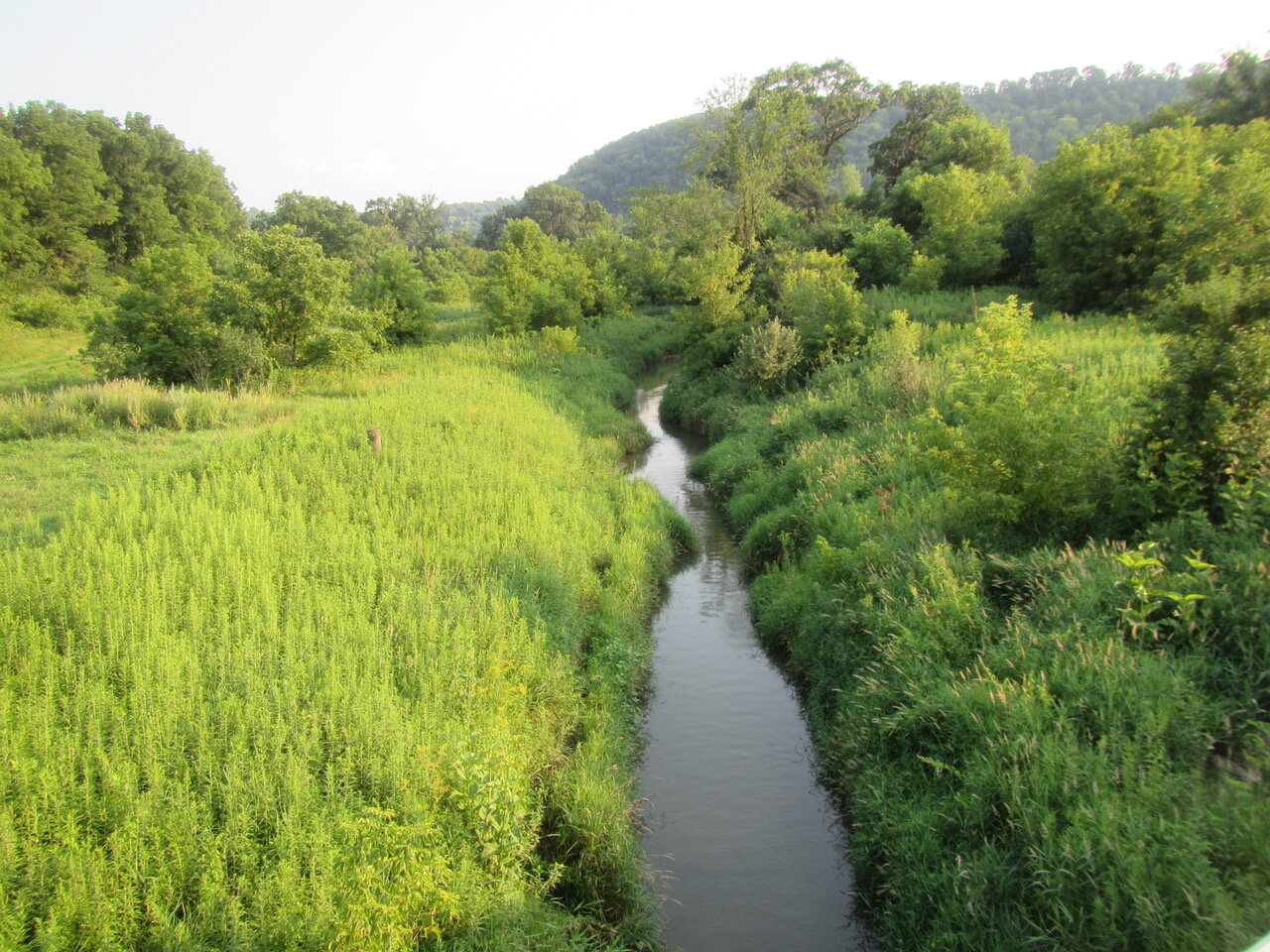This article is part of a larger series that investigates what we know about local tributaries around Lake Pepin. Follow us on Facebook and sign-up for our e-newsletter so you don’t miss the next release. If you have information or pictures for other Lake Pepin tributaries, please email us at: info@lakepepinlegacyalliance.org.
By: Emily Green
Gilbert Creek is a small trout stream that flows through northern Wabasha County, cuts across the easternmost corner of Goodhue County, and enters Lake Pepin and the Mississippi River via the Hok-Si-La campground just north of Lake City. Fed by several smaller tributaries—Sugarloaf Creek the only one of them named—Gilbert drains a central 16,007-acre portion of the encompassing Mississippi River-Lake Pepin (MRLP) watershed. Like its parent MRLP landscape, Gilbert Creek’s watershed includes a mosaic of rolling crop- and pasture lands and forested valleys that drop steeply toward the Mississippi.
Gilbert Creek Watershed, MPCA Report “Mississippi River-Lake Pepin Tributaries Biotic Stressor Identification”
As part of its statewide water monitoring program, the MN Pollution Control Agency (MPCA) has been monitoring the waters of Gilbert Creek and the other five MRLP streams since 2008. In 2011, Gilbert Creek was one of several found to have elevated levels of E. coli—a bacteria that is widely considered to indicate active fecal contamination—triggering aquatic recreation impairment status. Subsequent monitoring has shown little change in E. coli levels despite intensive land management efforts to stem potential sources and pathways of fecal bacteria into the streams. At the same time, questions are mounting as to whether the E. coli levels actually indicate fecal contamination or instead naturalized resident bacteria populations that may not necessarily warrant the same human health concern. If the latter, the water quality standard might ultimately have to be revisited (see previous LPLA Blog Post: Miller Creek).
Beyond assessing chemical impairments however, the MPCA’s 2011 monitoring effort also assessed all the streams for the health of fish and invertebrate communities and their habitat conditions. While most were found to support healthy aquatic life, Gilbert Creek had poor fish populations and fish habitat in its lower reach, resulting in its 2012 designation as impaired for aquatic life [1].
Gilbert Creek Fieldwork, MPCA, 2018
To assess a stream’s aquatic life, fish biologists look to see that certain native and desirable fish and invertebrate species are present in sufficient numbers and species associated with poor quality habitat are not present. According to MN DNR Regional Fisheries Manager Brian Nerbonne, the list of desirable fish species in Southeastern MN coldwater trout streams is short, including brook trout, slimy sculpin, and just a few others.
“The healthiest trout streams have just 3-4 species, kind of the opposite of how people normally think about healthy ecosystems, because there are so few species that can live in those cold temperatures,” Nerbonne explained.
Biologists also look to see whether a stream has specific habitat features that are necessary for the desirable fish species, and features that would limit the populations. According to Nerbonne, trout species require a coarse gravel streambed for spawning and gravel or cobble surfaces for harboring the invertebrates on which they feed. They need clear water as they are “sight feeders.” They also need areas of deeper water, and some overhanging limbs or woody debris to provide cover from avian predators. “A stream section without much cover generally won’t have much fish,” he added.
All relevant information goes into calculating Index of Biotic Integrity (IBI) scores (one IBI for fish and one for macroinvertebrates) for a water body. IBI scores below a certain threshold trigger the aquatic life impairment designation. In 2011, Gilbert Creek was found to be deficient in both streambed quality and cover, earning the lowest fish IBI score in the watershed and the biologists’ conclusion that its lower section “doesn’t support aquatic life” [2]. A 2012 DNR Stream Assessment report stated, “The lower end of Gilbert is a sandy bottom with high eroding banks. There are very few deep pools or fast riffles. This reach is poor trout habitat due to lack of cover and poor substrates.” MPCA staff concluded that sediment was one key stressor impairing fish habitat.
One of MPCA’s SE Region project managers Kristen Dieterman emphasized, “sediment can play a very big role in impairing fish habitat, both if being deposited or reworked in the stream bed.”
Index of Biotic Integrity (IBI) scores for fish in Gilbert Creek from 2008 to 2018. Lower Gilbert Creek was considered impaired, but conditions have continually improved. (Data Source: MPCA)
Since 2012, however, Gilbert Creek’s situation has changed remarkably. According to Dieterman, MPCA staff have added an additional monitoring site on Gilbert and several new rounds of monitoring have taken place.
“The IBI score has improved every time we’ve visited,” she noted.
Based on the new data collected, Dieterman said MPCA is now proposing that Gilbert Creek’s lower reach no longer be listed as impaired for aquatic life. Moreover, it is proposing that the upper reach be given an “Exceptional Use” designation--a new status under its Tiered Aquatic Life Use (TALU) framework that was adopted in 2018 to classify rivers and streams based on the quality of their fish and invertebrate populations.
According to the MPCA website, the Exceptional Use designation is given to streams where water quality is high enough to support fish or invertebrate communities “at or near undisturbed conditions.” Since its adoption, Dieterman shared that approximately 70% of the water bodies that have thus far been deemed Exceptional Use are in the Lake Superior and Rainy River Basins. Gilbert Creek’s upper reach is one of only two Exceptional Use stream reaches that have so far been identified in the southern one-third of the state.
“Overall, Gilbert Creek is a great success story–both the delisting of the lower reach and the recommendation for exceptional use ranking in the upper reach,” Dieterman declared.
Gilbert Creek, MPCA 2018
What explains the improvements in Gilbert Creek’s fish populations and habitat? Dieterman said no one can say for certain, even as she stressed the important relationship between watershed land use practices and in-stream fish habitat. She noted the Wabasha and Goodhue County Soil and Water Conservation Districts and their partners have been doing a tremendous amount of work with area landowners to reduce erosion and sedimentation in local streams.
MPCA’s Healthier Watersheds website, which highlights the water restoration and protection best management practices (BMPs) being done within watersheds and subwatersheds across the state, shows that as of December 2018 there had been 46 BMPs funded by the Clean Water Fund in the Gilbert Creek watershed including 430 acres with nutrient management strategies; 163 acres of cover crop plantings; 725 acres of tillage changes; and 7 new streambank, bluff, or ravine stabilization structures.
At this point, both the delisting of Gilbert Creek’s lower reach and the Exceptional Use designation for the upper reach are in process. The MPCA still has to compile all the available data, finalize its internal decisions based on the evidence, and make its case for both changes to the U.S. EPA. If accepted at that level, the status changes would be formalized in 2022.
Dieterman stressed that the exceptional use designation is permanent; those water bodies receiving it will be expected to forever maintain their current healthy fish and invertebrate populations, and corresponding IBI scores above a certain threshold. In the future, the aquatic impairment designation would be triggered for those waters if they fail to meet the higher standards. Dieterman noted that the designation doesn’t carry additional regulations, and that MPCA still needs to develop its framework for how to protect exceptional use waters, which could ultimately be in the form of site-specific standards. But she said the designation can help inform the management or project-permitting decisions by local partners.
“What excites me most is that the exceptional use listing can’t ever be changed…So Gilbert Creek would always be held to that higher bar,” Dieterman declared.
[1] Hay Creek had earlier been declared impaired for aquatic life due to high turbidity: https://www.pca.state.mn.us/sites/default/files/wq-iw9-15e.pdf
[2] The fish IBI in Lower Gilbert Creek was 42, below the threshold of 45 for streams of the southern coldwater class: https://www.pca.state.mn.us/sites/default/files/wq-ws3-07040001d.pdf
This article is part of a larger series that investigates what we know about eight Lake Pepin tributaries. Follow us on Facebook and sign-up for our e-newsletter so you don’t miss the next release. If you have information or pictures for other Lake Pepin tributaries, please email us at: info@lakepepinlegacyalliance.org.
Other articles in the series will be listed below as they are published:
Miller Creek: Water Protection Efforts Proceed In Miller Creek, Even As E. Coli Situation Baffles
Wells Creek: A Dynamic Stream With Many Trout, But Rising Sediment Concerns
Bullard Creek: Upland Water Storage Limits Erosion, But Its Sediment Still Impacts Wacouta Bay
Hay Creek: Restoration Efforts Have Made It a Top-Level Trout Stream
Emily Green is a writer, editor, and researcher with particular interests in environmental protection, climate change, and environmental civic engagement. She has an M.S. degree in conservation biology from the University of Minnesota and a B.A. in English.




